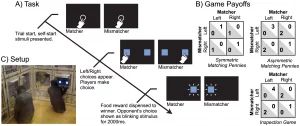Introduction:
There are many game theory contexts and applications in our daily life. Under the assumption that everyone is rational, we use game theory to predict others’ actions and make corresponding strategies on our own. From time to time, I think about whether there are rational creatures other than humans that utilize game theory or yield behaviors that generally follow the game theory predictions. “Can we find traces of game theory among animals other than just humans?” Such curious thoughts make me want to dive deeper into understanding the essence of game theory. Fortunately, I found an interesting paper that studied the behavior of chimpanzees compared to that of humans under a game theory context.
Methodology:
The investigation was carried out by Christopher Flynn Martin and Tetsuro Matsuzawa from the Department of Brain and Behavioral sciences of Kyoto University Primate Research Institute, et al.
At first, they designed 2 games, which are the Symmetric matching pennies and the Asymmetric matching pennies, for the six chimpanzees chosen for the study.

Figure 1
As shown above, the 2 players of the game will interact through the touch-panel screens which will first display both players the start button which is a circle. After both players click the button, they will see 2 new light blue square buttons which represent left and right. Then they will make a choice between the 2 buttons.
The rules of the game are self-explanatory on figure 1, which is if both players selected the same direction, Matcher (Player B as if in class) will get a reward. Else, Mismatcher (Player A as if in class) will get a reward. The reward is an apple cube.
The dual touch-panel competitive games are curious for these chimpanzees but they have also participated in other scientific and cognitive studies, so the data collected from them will be legitimate to be conducted analysis on.
Result and Analysis:
We can see from the payoff matrix in figure 1 that there is no pure-strategy Nash equilibrium in both games. However, mix-strategy equilibrium can be obtained.

Figure 2
After rounds of data collection and enumeration, we get the diagrams shown in figure 2.
In the diagrams, the y-axis is the frequency or probability of the mismatcher choosing right, the x-axis is the frequency or probability of the matcher choosing right. The black square labeled NE is the mix-strategy equilibrium. Triangles of different colors stand for the choice strategies for different pairs or groups of participants.
From the diagrams of Symmetric matching pennies and Asymmetric matching pennies, we can notice that the strategies of the six chimpanzees in 3 pairs are relatively close to the mix-strategy equilibrium, and it is not a coincidence.
This closeness of the chimpanzees to the Nash equilibrium was observed even closer than that of humans from previous discoveries. Therefore, to further compare chimpanzees’ and humans’ choices, a third game is played.
As we can tell from the above 2 figures, this third game is named inspection game which is similar to the Asymmetric matching pennies. The difference is that this time both chimpanzees and humans are involved, and there are 2 human groups. The reward for Japanese humans and African humans is 1 Yen or 100 Guinean Franc bills, respectively. Humans are not allowed to talk to each other.
From figure2(c), we can clearly see that the chimpanzees are indeed making choices that are closer to the Nash equilibrium than those of humans.

Figure 3
Here are another 2 graphs modeled from the data in the inspection game.
In figure3(a), the y-axis is the learning rate, and the x-axis is the response difference from the payoff matrix. We can see that chimpanzees tend to have higher learning rates and smaller response differences than those of humans.
In figure3(b), the y-axis is the level of detectable learning, and the x-axis is the likelihood-ratio (LR) statistic. The more the LR statistic, the more likely the learning. It is obvious that chimpanzees are more willing to learn than humans on every detectable learning level.
There are 3 games played in total.
Conclusion:
All the figures illustrated above reveal that overall, compared to humans, chimpanzees make choices that are closer to the Nash equilibrium, and they are more willing to learn. An ecological reason for this, as suggested by Martin et al, could be that chimpanzees engage in competitive payoff games, such as wrestling, looting food from human farms, and establishing dominance hierarchy, more often in their wild lives than human, and on the other hand, human take more part in cooperative play in the society. As for why chimpanzees have such a high learning rate and learning willingness, since these potential games with payoffs are ubiquitous in chimpanzees’ lives, as per the evolutionary theory, they have adapted cognitive skills to predict opponents’ behaviors to take corresponding measures.
Throughout the entire study, we can conclude that chimpanzees are a rational species, and game theory plays an important role for them to maximize their payoffs. Therefore, as long as the creature is rational, the answer to the question in the introduction, “Can we find traces of game theory among animals other than just humans?”, could be yes.
References:
Martin, C., Bhui, R., Bossaerts, P. et al. Chimpanzee choice rates in competitive games match equilibrium game theory predictions. Sci Rep 4, 5182 (2014). https://doi.org/10.1038/srep05182